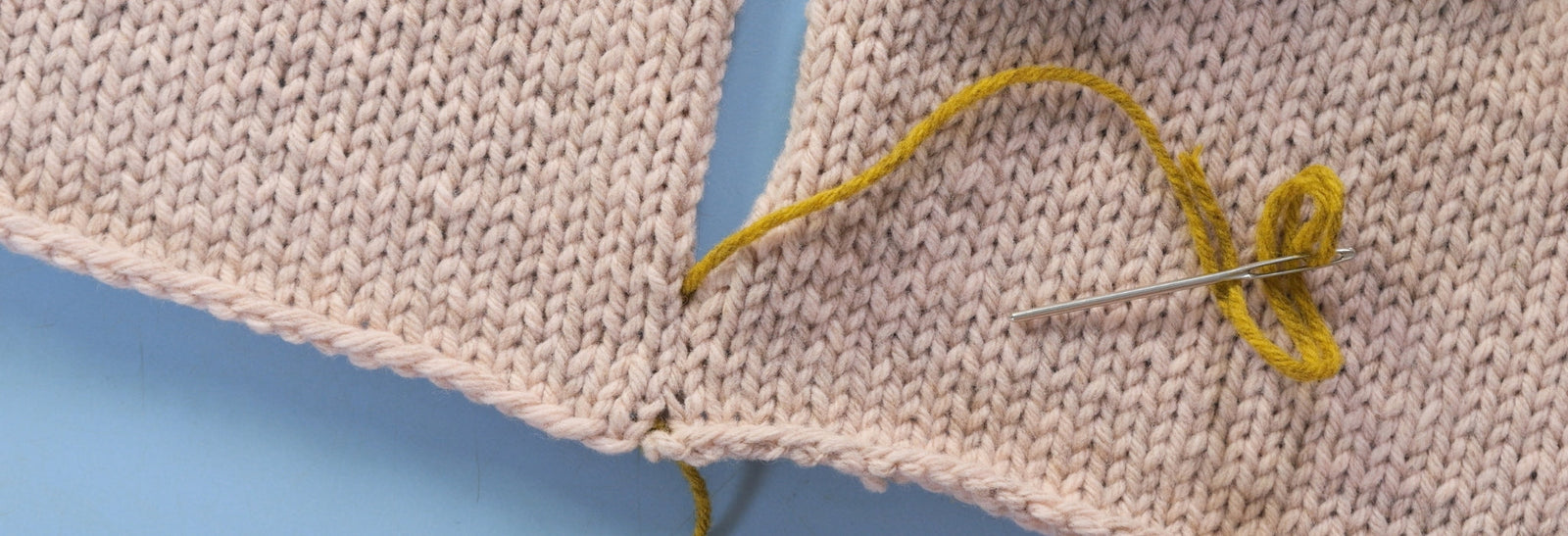Your Cart is Empty
Using charts, even if you hate them
December 02, 2009
Personally, I like working from charts, but I recognise that lots of people find them difficult to follow and prefer written directions. Sometimes people who don’t like charts simply haven’t learnt to use them and in that case I’d certainly recommend giving them a shot, even if you conclude that you prefer working from the words, charts can be a valuable aid.
Let’s look at an example using a fairly simple, traditional lace pattern, the one I used in the cuffs of the Veyla pattern. First, here are the written directions (abbreviations):
Row 1:(k1, yo) twice, k1, ssk, p1, k2tog, k1, p1, k1, ssk, p1, k2tog, (k1, yo) twice, k1.
Row 2:p6, (k1, p2) twice, p1, k6.
Row 3:k1, yo, k3, yo, ssk, p1, k2tog, p1, ssk, p1, k2tog, yo, k3, yo, k1.
Row 4:p9, k1, p9.
Row 5:k1, yo, k5, yo, sl1, k2tog, psso, p1, k3tog, yo, k5, yo, k1.
Row 6:p to end.
Row 7:k1, yo, k3, p1, k2tog, k1, yo, sl1, k2tog, psso, yo, k1, ssk, p1, k3, yo, k1.
Row 8:p5, k1, p7, k1, p5.
To some people that block of text with no visual clues will be impossible to keep track of, but for plenty of others it’s easy to read and follow the rhythm of and that’s fine, different brains work in very different ways. The problem is that however much written directions suit the way you think that there is nothing in that block of text to suggest how the pattern is actually supposed to look.
Of course a pattern usually contains some sort of photo of the stitch pattern, but this isn’t always close up and clear enough to see exactly what’s going on with every single stitch. Additionally, as anyone who has ever frogged lace without a life line knows it can be difficult to see clearly which stitches belong to which row.
Ideally you’ll be able to follow the written directions and trust that everything will come out perfectly. Which is a nice idea, but in practice the phone rings and you forget where you were or you get too into what you think is the rythym of the pattern and miss a change. Mistakes happen, what matters is that you can identify and fix them and that’s where having an idea of how the pattern should look and how everything lines up can help.

For example, on this swatch (there are 3 stitches worked in garter stitch on either side to keep things flat) I was knitting along happily until I got to the end of row 5 and realised that I was short a stitch to complete the row. First I’d presume that I’d made a mistake earlier in the row, so I’d carefully check each stitch against the directions. If I couldn’t find a problem I’d probably assume that I just wasn’t seeing it and try re-knitting the row. Still a stitch short I’d have to conclude that the problem was in the previous right side row so I’d take that out and re-knit it, possibly realising in the process that I’d missed out the 1st yarn over in row 3. Problem fixed, but with far too much frustration. In a little swatch like this that process isn’t a huge deal, but on something like a shawl it can be impossibly frustrating, especially if you have to go through it more than once.
Eventually you might have knit enough repeats to be able to read what you’ve already knit and see how everything lines up, but it’s nice to be able to do that from the beginning. If I’d studied the chart a little before beginning to work from the written directions I’d have been able to learn some valuable information that would have made spotting where I’d missed a yarn over a lot easier. If you’re not familiar with charts – read the odd, right side rows from right to left and the even rows from left to right, scroll down for the key.

I’ve shaded in the yarn overs in the chart to highlight how easy it is to see at a glance how they line up. The pink ones form columns at either side and the green ones create diagonal lines, sloping in towards the centre. You can also see at a glance the lines created by the decreases and purl stitches.

Here I’ve shaded the yarn over I missed in yellow so you can see that with the knowledge provided by the chart it would have been a lot easier to find the mistake in my knitting, realise I’d made a mistake earlier and possibly have seen the problem just after making the mistake. Which makes it a lot easier to fix!

This is an interesting example, because it’s not the easiest type of chart to read at a glance and see what’s going to line up. In the simplest lace patterns every yarn over will be preceded or followed by it’s corresponding decrease before another yarn over is worked and you can expect that your knitting will line up exactly like the chart. Here’s an example of a chart like that.

In the main example the yarn overs and decreases are balanced on every row (there are equal numbers of stitches increased and decreased so the overall stitch count doesn’t change), but they don’t alternate. In most of the rows a set of yarn overs are worked before a set of decreases, which means that you’re increasing stitches in one section and decreasing them in another and that means that not everything in your knitting will stack up visually exactly the way it does in the chart.
This isn’t a huge problem though, it just means that you need to work a little harder to pick out the key information that will help you to read your knitting and keep track of whether it looks right. It’s pretty clear that the chart is symmetrical so you can expect the central purl stitches to be stacked on top of each other and for the pattern to be mirrored on either side. There is clearly only one edge stitch next to the outer columns of yarn overs so those must also be stacked on top of each other.
Sometimes, when the decreases and yarn overs in a chart are grouped separately the designer will use a no stitch symbol to make it easier to read, these are often used in patterns where the stitch count varies too. Of course they could just subtract and add those stitches at the edge of the chart, but putting them within the pattern allows it to be charted in the way that most closely matches how the actual knitting will look. You just ignore those “no stitches” while knitting, but they’re there to make your life easier. You can see this in action in this segment from the Snapdragon Tam chart, they’re used to keep everything lined up in the chart the way it will be in the knitting.

I hope that helps to show how charts can be a useful tool, whether or not you find you prefer them to written directions. They can help you to read your knitting and see whether everything is in the right place, important skills for a “thinking knitter”.
Many knitters like to work from both the written directions and the charts, like Mary-Heather who says – “I usually get going with written instructions for the first repeat (matching with the chart visually) then after that I use the chart”. In fact, while the chart can give you a good visual overview, the written directions can be helpful for learning the rhythms of the pattern, the (yo, k2tog) twice stuff, and for setting everything up in the right place, since the stitch counts are given for each bit.
Key:

Also in Journal

Learn to Knit: Mattress Stitch
March 29, 2023
By following our step-by-step mattress stitch knitting tutorial, you'll learn how to make your seams look beautiful and how best to prepare your knitting so that when you seam it with mattress stitch, it goes smoothly on the first try.
Read More
How to Knit a Scarf: A Beginners Guide to Scarf Knitting
March 23, 2023
Want a quick and easy beginners tutorial on how to knit a scarf? This garter stitch scarf is easy to knit and requires just 3 skills; casting on, the knit stitch and casting off.
Read More
Learn to knit: the long tail cast-on
February 03, 2022
The long tail cast on is a great multi-purpose knitting cast on and the perfect place for beginner knitters to start. Learn how to work the long tail cast on and how to estimate the length of yarn needed with our clear step by step tutorial and video.
Read More Recent Articles
- Learn to Knit: Mattress Stitch March 29, 2023
- How to Knit a Scarf: A Beginners Guide to Scarf Knitting March 23, 2023
- Learn to knit: the long tail cast-on February 03, 2022
- How to Kitchener Stitch December 09, 2021
- Crochet Provisional Cast-on December 02, 2021
- Learn to knit: How to knit in the round with double pointed needles November 25, 2021
- Learn to knit: How to knit in the round using the magic loop technique November 25, 2021
- Learn to knit: How to knit in the round November 25, 2021
- Knitted Gift Ideas for you and your loved ones November 18, 2021
- Celebrating our Porty Hat Preview Knitters October 28, 2021
Free resources
-
KALS, step-by-step pattern guides and free patterns
Learn brioche with the free Daniel's Hat pattern
Tombreck - a free chevron beanie pattern
Working the brioche neck detail on the Polwarth sweater
Basics
Casting on
Decorative Channel Island Cast-on
Binding off
3 Easy Stretchy Bind-offs (p2tog bind-off; k2togtbl, k1 bind-off; Jeny's surprisingly stretchy bind-off)
Tubular Bind-off for brioche stitch
Increasing
Paired increase methods compared
Decreasing
Brioche stitch double decreases
Knitting in the round
How to Knit in the round using Magic Loop
How to Knit in the round using DPNs
Short rows
Swatching and gauge
Tips and tricks
Avoiding ears when binding off
Tighter purl stitches for neater cables and ribbing
Cabling without a cable needle
Reading knitting patterns
Understanding "continue in pattern"
Finishing
Garment knitting
Joining the body and sleeves on a seamless bottom up sweater
Sizing
Inclusive garment knitting
How to pick a garment without a model for you (specifically addresses finding garment patterns when your gender identity isn't represented and the styles you want to knit might not be sized to fit your body)
How does ease affect inclusive size ranges?
Specific stitch patterns
Lace
Identifying and fixing mistakes in lace knitting
Colourwork
Getting started with stranded colourwork
Understanding colour dominance
Working stranded colourwork over small circumferences
Decreases in stranded colourwork
Holding the yarn for stranded colourwork
Ladderback Jacquard (a neat way to deal with long floats)
Cables
Cabling without a cable needle
Cabling without a cable needle on the wrong side
How to knit cabled decreases
Closed ring cable increases and decreasesBrioche
How to work brioche stitch in the round
Other crafts
Cross stitch
How to begin your first large cross stitch project
How to finish a cross stitch project with an embroidery hoop frame
Mending

Sign up today
Find out the latest news from the studio such as sales, pattern releases, and new workshops or KALs our learning community, The Knitwork. We also share helpful tips and exclusive subscriber discounts...

